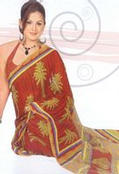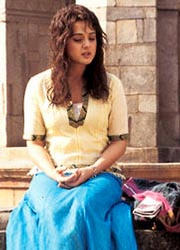History Of Sari And Skirts
History Of SARI
saris origins are obscure, in part because there are so few historical records in India. Yet, we know that Indians were wearing unsewn lengths of cloth draped around their bodies long before tailored cloths arrived. One of the earliest depictions of a Sari-like drape covering the entire body dates back to 100 B.C. A North-Indian Terracotts depicts a woman wearing a Sari wound tightly around her entire body in the trouser style. This elaborate body-hugging style represented in the terracotta may have evolved among India's temple dancers in ancient times to allow their limbs freedom of movement while at the same time maintaining their standards of modesty. There are many sculptures of Graeco-Indian Gandharan civilization which show a variety of different Sari draping styles. Tailored clothes arrived in India with the arrival of Muslims. Hindus beleived that any cloth pierced by needles was impure. It is commonly beleived in India that today's petticoat or "Ghagra" and the blouse or "Choli" which are worn under the Sari are later additions which started with the coming of British in India. Increasing number of upper class women in the early 20th century did adopt items of European style clothing as the fitted blouse and slim petticoat. This was also adopted due to the fashion of transparent chiffon Saris during that particular period. Some of the wives of Indian Kings draped themselves in Saris that were made by Parisian designers. The concept of beauty in ancient India was that of small waist and large bust and hips, as is evident in the sculptures of those times. And Sari seemed to be the perfect dress to flaunt those proportions as it exposes the waist of a woman and emphasises the waist and bust with the pleated fabric. Sometimes women wore accesories like Girdle(a belt) with elaborate design around their waist to emphasize the hip area. |
History Of SKIRT
1914 -18 Changes for Women
Socio economic changes that occurred during the First World War 1914-18 and became accepted, changed the role of women in a way that no amount of campaigning by a few liberated ladies could have.
The Flapper
The costume history image in our minds of a woman of the 'Roaring Twenties' is actually likely to be the image of a flapper. Flappers did not truly emerge until 1926. Flapper fashion embraced all things and styles modern. A fashionable flapper had short sleek hair, a shorter than average shapeless shift dress, a chest as flat as a board, wore make up and applied it in public, smoked with a long cigarette holder, exposed her limbs and epitomised the spirit of a reckless rebel who danced the nights away in the Jazz Age. The French called the flapper fashion style the 'garconne'.
Attainable Fashion for All
High fashion until the twenties had been for the richer women of society. But because construction of the flapper's dress was less complicated than earlier fashions, women were much more successful at home dressmaking a flapper dress which was a straight shift. It was easier to produce up to date plain flapper fashions quickly using flapper fashion Butterick dress patterns.
The flapper fashion style flourished amid the middle classes negating differences between themselves and the truly rich, but continuing to highlight some differences with the really poor. The really rich still continued to wear beautifully embellished silk garments for evening, but the masses revelled in their new found sophistication of very fashionable flapper clothes.
The Short Skirt Misconception of the Twenties
New students of costume history often mistakenly assume that all dresses day and evening were short in every year of the twenties and that flappers were the only fashion style of the twenties. Dress and coat lengths were actually calf length and quite long for most of the decade. Shortness is a popular misconception reinforced by the availability of moving film of the Charleston dance which shows very visible knees and legs on the dancing flappers.
Skirts only revealed the knee briefly between 1926 and 1928, and this was the only period when evening dresses were short in line with day dress lengths. This was the flapper period.
Dating the Twenties Hemline
From 1913 the hemline had begun to show a little ankle.
Between 1916 and 1929 hemlines rose steadily, faltered then rose again.
In 1918 skirt lengths were just below calf length.
In 1919 skirt lengths were calf length.
Between 1920 and 1924 skirts remained calf length with fluctuations of an inch or two according to garment style. Skirts were actually still rather long, but were designed to confuse.
Gradually by degrees they gave the illusion of being first long and then shorter with dipping, scalloped and handkerchief hemlines in floating fabrics. It was only in 1925 that skirts rose 14 to 16 inches (45 to 50 cm) from the ground making the shorter hemline we associate with the era.
By 1926 skirts were at their shortest in the Twenties decade and showed the knee until 1928. The whole leg as far as the kneecap was revealed.
By 1929 uneven hems and asymmetric skirt hemlines again helped the transition to longer skirts. Longer sheer overskirts and semi sheer top skirts were worn over shorter linings. By 1930 the hemline was several inches below the knee.
~
The Masculine Silhouette of 1920's Females
After the war when women's dress became more mannish, each year seemed to get more severe in line which almost emphasised the feminine woman beneath. Female clothes became looser and more shapeless in fit. The bust was suppressed, the waist disappeared, the shoulders became broader and hair shorter and shorter. Narrow boyish hips were preferred. The silhouette emphasised a flattened chest and womanly curves were eliminated as the line became more simplified.
The Flat Chest of the Twenties
The slender flat chested tanned body and face of a 15 year old became the desired silhouette of the bright young things of the 1920s. Health and beauty clubs helped women refine their silhouettes whilst getting fitter and healthier.
It was a difficult time for the former matrons of Edwardian society, the previous leaders of fashion whose style of dressing became as passé as their rounded figures and older faces. More youthful women who could party all night and carry the boyish fashions well were all the rage.
The 1920's Bra
The bras of the early 20s include home made ones in white cotton and which were little more than bust bodices with extra separation. Some purchased bras were like camisoles and they offered no support.
Big busted girls turned to bandaging their breasts flat, but many adopted the Symington Side Lacer, a bra that could be laced at both sides and pulled and pulled in to flatten the chest.
For young ladies with youthful figures a satisfactory bra was the four sectioned lace bandeau bra, lined in net. None of the bras gave much shape, but few ladies were seeking anything more than stopping the bust from wobbling. As long as they looked boyish they looked fashionable.
By the 1930s Triumph, Maidenform, Gossard, Warner Brothers, Spirella, Twilfit and Symingtons were all making bras that did the job of separating the breasts. At the same time it was finally acknowledged that women had differing cup sizes and bra sales doubled with the new designs.
Girdles and Underwear
Between 1920 and 1928 corset sales declined by two thirds, but it adapted to changing needs. Fast flappers refused to wear corsets and rolled their stockings to the knee to enable them to dance easily. Long Corsets produced the boyish figure, but instead of thick boned corsets many women preferred thin elastic webbing Lastex girdles that flattened the abdomen. Suspenders were attached to the girdles. Underwear was minimal, sheer and lightweight. Women wore cami-bockers (directoire knickers and chemise) or cami-knickers or knickers and a petticoat.
An Air of Nudity in Stockings and Bare Arms
Although the 1950s are thought of as the first time of the teenager and the 1960s as the era when the young first led fashion there is no doubt that the possession of a youthful body was a prerequisite of twenties fashion.
The arms were bared not only for evening, but also for day and the legs were covered in beige stockings visible to the knee which gave an overall more naked look than ever before. Feet, ankles and calves formerly hidden and encased in black stocking were suddenly on show. Young women always wore black wool stockings until the end of World War I.
By the 1920s stockings with patterns were hot fashion items. Embroidery snaked around the ankles and up to the knees. Flesh and soft pastel colours were popular and they were made in either silk or artificial silk known as art silk later called rayon. The rayon stockings were very shiny so girls powdered their legs to dull them before venturing out. Names of stocking colours were Honey Beige, Teatime, Rose Morn, Boulevard and Spanish Brown. Lastex, a rubber based thread was used in knee highs in bright colours.
Gabrielle 'Coco' Chanel
The great fashion designer Gabrielle Chanel 1883-1971 self styled herself to be known as Coco Chanel. By 1920 the silhouette of her clothing designs have come to be the epitome of 20's style. The work of other famous designers beside hers seemed old fashioned and outmoded belonging as they did to the pre World War One era.
She promoted the styles we associate with flappers. She worked in neutral tones of beige, sand, cream, navy and black in soft fluid jersey fabrics cut with simple shapes that did not require corsetry or waist definition. They were clothes made for comfort and ease in wear making them revolutionary and quite modern. She was the Jean Muir or Donna Karan of her day and the originator of the LBD - that little black dress.



